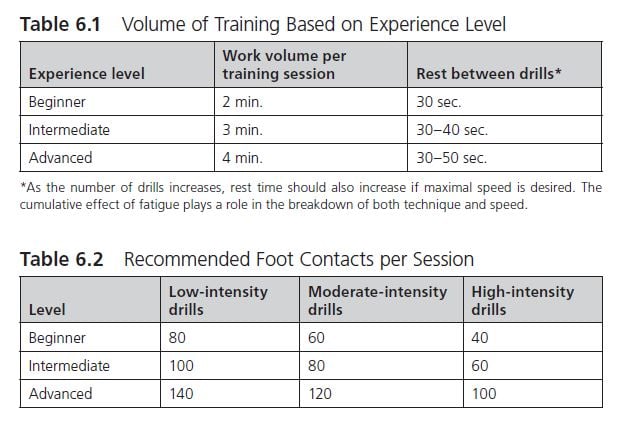Intensity and Volume by Drill Type
by Developing Agility and Quickness
Kinetic Select
June 2017
Coaches can use drills to improve quickness and agility. The training session can improve the specific areas needed to increase performance results by setting up appropriate intensity levels, duration of drills, recovery periods, and volume of drills.
The following is an exclusive excerpt from the book Developing Agility and Quickness, published by Human Kinetics. All text and images provided by Human Kinetics.
For line, ladder, and cone drills, the total number of sprints is determined by experience level and is measured as total work time. For example, if athletes perform five drills of 5 seconds each, the total work volume would be 25 seconds. Table 6.1 shows the total sprint volume for agility work for different experience levels. These standards and guidelines are very useful for athletes and coaches. They include a variety of drills and patterns for any agility or quickness program.
Coaches need to monitor volume and intensity, using drills to improve quickness and agility and not just to add a conditioning component to exercises. The training session can improve the specific areas needed to increase performance results for agility and quickness by setting up appropriate intensity levels, duration of drills, recovery periods, and volume of drills.
Dot drills are recorded by the number of single-foot contacts with the ground per session (not the number of contacts per exercise). For example, four sets of 10 reps with a type of movement that involves both feet would result in 80 repetitions. Table 6.2 provides volumes for varying levels of intensity. This table assumes that each movement is done at 100 percent effort. However, when attempting new drills, athletes should use slower speeds until they have mastered the technique. They may progress to full speed when they have demonstrated proficiency.

Note that the rest periods between sets should not be shorter than two minutes unless the work period is very short. Rest periods shorter than two minutes limit the total amount of work that athletes can perform, decreasing the effectiveness of the training program. Very short rest periods do not allow for complete recovery of the ATP-CP energy system (see the following section for more information) or for the removal of lactic acid.
From the National Strength and Conditioning Association (NSCA) comes this resource packed with more than 100 drills to help in the development of agility and quickness training programs. Applicable to almost every sport, Developing Agility and Quickness focuses on improving athletes’ fleetness of foot, change-of-direction speed, and reaction time. The book is available in bookstores everywhere, as well as online at the NSCA Store.
- Privacy Policy
- Your Privacy Choices
- Terms of Use
- Retraction and Correction Policy
- © 2025 National Strength and Conditioning Association